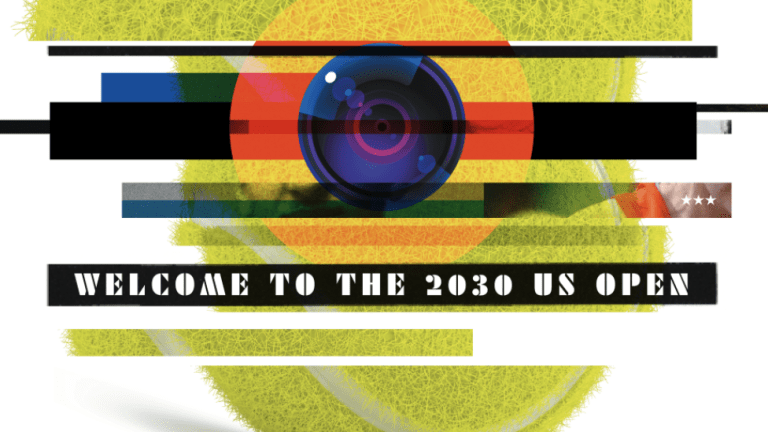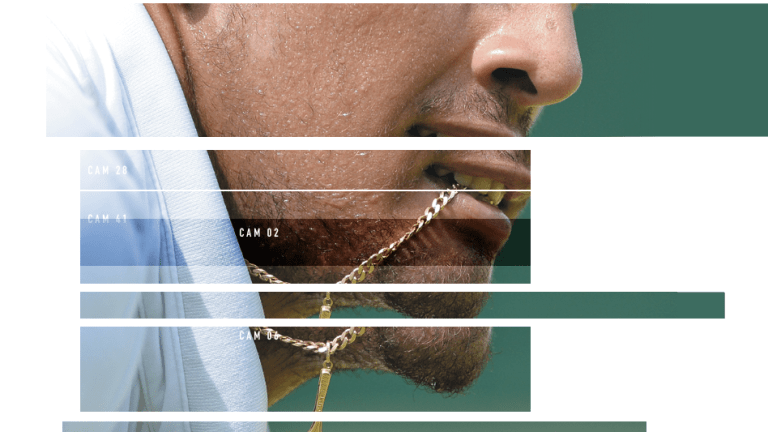US Open
Brave New Tennis World: Welcome to the 2030 US Open
By Joel Drucker Aug 23, 2019US Open
Coco Gauff led the way, but it was a wildly successful US Open for American tennis at large
By Peter Bodo Sep 13, 2023US Open
Daniil Medvedev was stubborn to a fault at the US Open, but still came away a winner
By Peter Bodo Sep 13, 2023US Open
With the Grand Slam season in the books, what's the state of the ATP Tour in 2023?
By Joel Drucker Sep 12, 2023US Open
Four Grand Slam winners, five storylines: The state of the WTA in 2023
By Joel Drucker Sep 11, 2023US Open
Novak Djokovic put on one of his most impressive physical and tactical performances to win a 24th Grand Slam title
By Steve Tignor Sep 11, 2023US Open
Novak Djokovic wins the US Open for his 24th Grand Slam title by beating Daniil Medvedev
By Associated Press Sep 11, 2023US Open
Novak Djokovic has won 24 Grand Slam titles. Here is a look at each one
By Associated Press Sep 11, 2023US Open
Djokovic celebrates No. 24 with a tribute to Kobe Bryant, who wore that number and became a friend
By Associated Press Sep 11, 2023US Open
Novak Djokovic's US Open title gives him 24 Grand Slam titles. No one in tennis history has won more
By Associated Press Sep 11, 2023US Open
Brave New Tennis World: Welcome to the 2030 US Open
How will the sport's biggest tournament look and feel in the future?
Published Aug 23, 2019
Advertising
It’s Wednesday, August 28, 2030, day five of this year’s US Open. As is the case at every major, tennis’ Grand Slam tournaments take place over the course of three weekends. Each commences on a Saturday at high noon, with a grand kickoff ceremony honoring past champions and community notables who love the sport. It was fantastic to see 86-year-old Billie Jean King swat the opening ball prior to Sofia Kenin’s first-round match. Everyone is curious to see which one of Serena Williams’ children will have. And it will be great when Novak Djokovic, Kim Clijsters and Caroline Wozniacki take time away from their duties at the United Nations in Manhattan and stop by.
As the action gets underway, a pair of fans, Roy and Susan, swiftly pass through the eye-recognition security system and make their way out to the field courts. Roy and Susan hold lower-bowl seats inside Arthur Ashe Stadium. Thirty minutes after they enter the grounds, they have yet to claim those seats. At this point, the “People’s Seat” app notifies fans that there are two vacancies that can be claimed on a first-come, first-serve basis.
It’s great to see the quality seats always filled. Later in the day, when Roy and Susan want to take their seats, they’ll tap on Susan’s iPhone XX to alert the occupants that it’s time to leave. After a bit of a learning curve in the mid-’20s, players got used to fans being able to come and go from of their seats, as they do at other major sporting events. This worked particularly well when Davis Cup and Fed Cup were combined at the 2028 Olympics.
For the eighth consecutive year, not a drop of rain is forecasted during the tournament, the dry conditions likely the result of climate change. The roof above Ashe is still a nice touch.

Brave New Tennis World: Welcome to the 2030 US Open
Advertising
The action moves briskly, as the courts have been made significantly faster. Defending champion Stefanos Tsitsipas is facing a rising serve-and-volleyer from Iceland who stands 6’9” and was inspired by Reilly Opelka’s run to the 2025 Roland Garros title. It was amazing how Opelka used kick serves and angles to conquer the clay and trigger a volleying renaissance.
The only official on the court is a chair umpire. All lines are called electronically. An automatic stringing machine is next to the umpire’s chair. Both players practiced an hour ago on a nearby court, so play commences immediately after the cyber-spin.
Wielding his slightly longer, 28-inch serving racquet—strung three pounds heavier than his 27-inch receiving frame—Tsitsipas opens the match with a slow, wide slice: a mere 120 M.P.H. That’s about 40 M.P.H. less than a typical first serve fired down the T.
According to Craig O’Shannessy, a tennis strategy analyst who’s worked with such pros as Djokovic and Kevin Anderson, “The year 2030 seems like it’s in the distant future, but it’s only 11 years away. Over this period of time, technology is going to be fully embraced by the tennis community and will be a key weapon for players at the top level of the game to forge a critical advantage. Serving, returning, rallying and approaching will all be tracked in far greater detail so that opponent tendencies in specific strategies are known. In all situations, the highest percentage pattern of play will be understood and readily employed.”
Of course, everyone remembers the way Tsitsipas began last year’s final against Nick Kyrgios: he hit four straight underhand serves. On the fourth, when Kyrgios stood on the service line, Tsitsipas nailed him in the chest. Kyrgios, himself having hit 34 underhand aces on his way to the final, could only clap and say, “Well done, mate.” Kyrgios’ coach, Stephen Curry, agreed; they’ve since devised an underhand serve return strategy.

Brave New Tennis World: Welcome to the 2030 US Open
Advertising
On this day, Tsitsipas has opted out of the on-court coaching option, wherein a coach sits on the court for the entire match. After much tussle about this topic, it was agreed that since there was no way to police it, on-court coaching might as well be legalized. But when Serena and Roger Federer continued to win titles into their 40s without ever seeking coaches, many players decided they didn’t want anyone on-court either.
On the other hand, British Fed Cup captain Andy Murray has shown how valuable coaching can be—his insights into the game are so compelling that his changeover commentaries were made into an award-winning documentary for the Apple Watch network.
Since players can accept input, it’s perfectly fine for the Icelander, after dropping the first set, to connect his racquet to his watch, examine where he’s making errors, and note how Tsitsipas is taking the ball earlier than he had in their prior matches.
Viewers across the globe have their own version of a personal control room—an on-screen feature that reveals all 18 on-court cameras. As you watch a match, you can click on the camera angle you prefer at any time.
Fans also have their choice of commentators. “I like the way this man from Iceland uses his slice backhand,” says a familiar voice. It’s Federer, on The Roger Federer Channel. Feliciano Lopez, calling the action with Nicolas Mahut on the Netrushers Channel, asks, “Who taught this guy how to volley?” Mahut points out that there was no specific instructor in Iceland; the player mastered the volley by donning a Virtual Reality suite for two hours a day between the ages of 10 and 14.
Early in the third set, the Icelander tumbles for a volley and winces. He’s tweaked his left knee—an injury that in a previous era might have forced a default. But in this case, he is treated rapidly on the changeover.
According to Faith Popcorn, the CEO of the futurist trend marketing agency BrainReserve, “there will be on-demand health pods that can treat you in moments to get you back playing. There are prototypes of autonomous medical pods that can come and x-ray you with no human involvement.”
After the match, each player enters the Global Chat Zone. Throughout the match, questions have poured in from around the world, in a wide variety of languages, which are instantly translated to each players’ native tongue. Each player’s answers are then immediately shared. Most top players have what are now called “Personalized Content Sites,” complete with instant highlights, quotes and stories.

Brave New Tennis World: Welcome to the 2030 US Open
Advertising
One of the most engaging parts of the majors is the Racquet Sports Festival. Played over the course of two days during the middle weekend, the RSF has most recently been dominated by pickleball greats Gael Monfils and Bethanie Mattek-Sands, and the amazing squash skills of Fabrice Santoro and Hsieh Su-wei. There’s lots of talk about how these sports might be integrated into the Olympics, especially after seeing how smoothly it went in ’28 when, at last, the tennis event became a dual-gender team competition.
But many US Open attendees don’t just come to watch the tennis.
“We’re on the cusp of AR and VR integration with entertainment,” Popcorn says. “You will be able to enter a VR world and volley with Federer, or meet up with BJK circa 1972—in avatar form, that is—for a match.”
Roy and Susan each take time to enter the Hall of Icons and spend an hour enjoying a hit with the greats. It was quite sobering for Roy to be passed by Ken Rosewall’s sharp backhand, and then come face-to-face with Madison Keys’ 135 M.P.H. serve. Slow by today’s standards, it’s still much too fast for Roy to handle.
Equipment has also evolved. Racquet-head sizes have gotten even bigger, especially among recreational players. The 150-square-inch frame introduced in ’22 helped tennis overtake badminton as Malaysia’s most popular sport, and triggered a series of booms throughout Southeast Asia, Northern Africa and, again, in the U.S.
Condensed tournaments have risen in popularity, in the form of one day, 10-point tiebreaker “shoot-outs” that are often played alongside pickleball tournaments. The quality of lighting at most tennis centers has improved so much that it’s possible to play these events well into the evening.
A few years ago, the USTA created 40 community tennis-viewing spots throughout the country. From old-school venues like the Longwood Cricket Club near Boston to Golden Gate Park in San Francisco, these spaces typically host up to 2,000 people at a time to watch events like the US Open on massive TV screens.
One of the most-watched US Open matches in history took place in 2027. With men playing shorter matches, there’s been a resurgence in mixed doubles. To see the nation watch fellow 46-year-olds Federer and Martina Hingis win the final was quite a sight.
Many of these ideas are plausible. Others, who knows? Either way, it’s fun to imagine how tennis will change in the coming decade. Technology will only continue to make its presence felt. Fans will hopefully benefit from further innovations. And through it all, the story of tennis will continue to unfold in ways we can’t even imagine.
As Billie Jean King once said, “It’s the people who know the past who can innovate. You take what’s been great and then you build on it to create something new.”

Brave New Tennis World: Welcome to the 2030 US Open